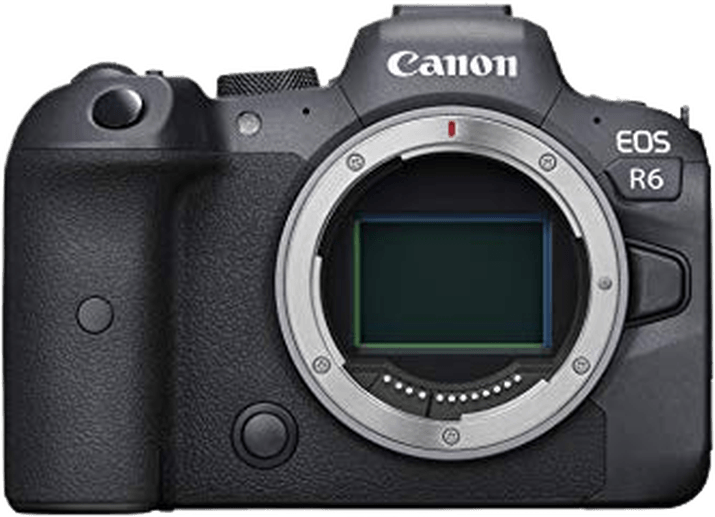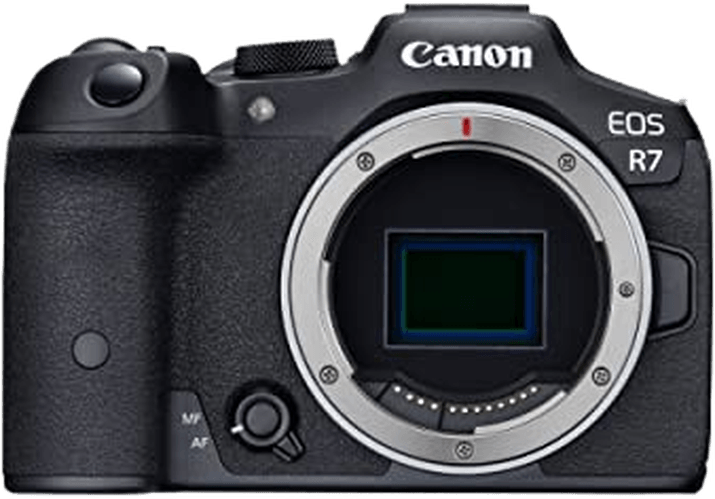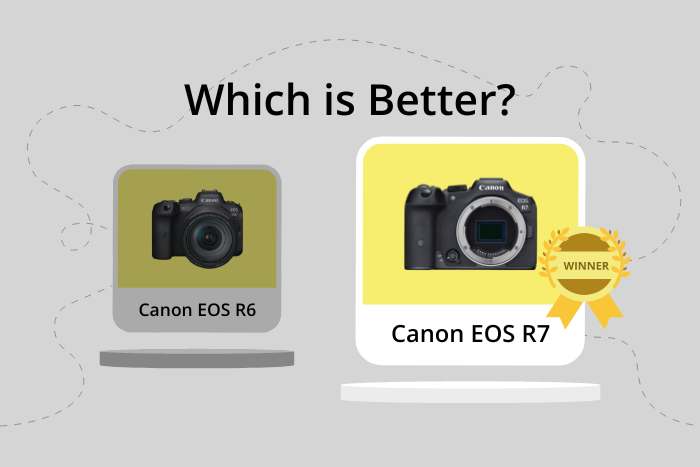Canon EOS R6 vs EOS R7 Comparison
Canon EOS R6

Canon EOS R7

The Canon EOS R7 outperforms the Canon EOS R6 with a score of 83/100 compared to 80/100. Both cameras are mirrorless and have similar dimensions, with the R6 measuring 138 x 98 x 88mm and weighing 680g, while the R7 is slightly smaller and lighter at 132 x 90 x 92mm and 612g.
The R7 excels with its more recent release date in 2022 and a lower launch price of $1500, making it a more affordable option. On the other hand, the R6, released in 2020, has a higher launch price of $2499.
Despite its higher price, the R6 is not without its merits. Its larger size and weight may offer a more substantial feel for those who prefer a heftier camera. However, the R7’s lighter weight and smaller dimensions make it a more portable and convenient choice for many photographers.
Taking all factors into consideration, the Canon EOS R7 emerges as the winner due to its higher score, more recent release, and lower price, while the Canon EOS R6 may still appeal to those who prefer a slightly larger and heavier camera.
Canon EOS R6 vs EOS R7 Overview and Optics
The Canon EOS R7 wins the optics comparison with a score of 82/100, while the Canon EOS R6 scores 79/100. Both cameras share several specifications, including a CMOS sensor, Digic X processor, Canon RF lens mount, and image stabilisation.
The EOS R7 outperforms the R6 with its higher megapixel count of 33 compared to the R6’s 20.1 megapixels. This difference allows the R7 to capture more detail and produce higher resolution images. Additionally, the R7 has a DXOMARK sensor score of 97, surpassing the R6’s score of 90. The higher DXOMARK score means the R7’s sensor provides better image quality, particularly in terms of dynamic range, color depth, and low-light performance.
On the other hand, the EOS R6 has a faster shooting speed of 20 frames per second (fps) compared to the R7’s 15 fps. This advantage makes the R6 more suitable for capturing fast-moving subjects and action photography. Furthermore, the R6 features a full-frame sensor, while the R7 has an APS-C sensor. The full-frame sensor in the R6 provides a wider field of view and better low-light performance compared to the smaller APS-C sensor in the R7.
In terms of optics, the Canon EOS R7 offers higher resolution images and better overall image quality due to its increased megapixel count and higher DXOMARK sensor score. However, the Canon EOS R6 excels in shooting speed and benefits from a full-frame sensor, making it a better choice for action photography and low-light situations.
Canon EOS R6 vs EOS R7 Video Performance
The Canon EOS R6 and Canon EOS R7 both have a video score of 91/100, indicating that they offer comparable video capabilities. Both cameras share the same maximum video resolution of 4K and video dimensions of 3840 x 2160. Additionally, they both have a maximum video frame rate of 120fps and built-in time-lapse functionality.
Despite having the same video score, the Canon EOS R6 has certain advantages over the Canon EOS R7. The R6 is known for its excellent low-light performance and impressive image stabilization, which contributes to smoother, more professional-looking videos. Moreover, the R6 has a larger buffer capacity, allowing for longer continuous video recording without interruptions. These factors make the R6 a better choice for videographers who prioritize high-quality footage and seamless recording.
On the other hand, the Canon EOS R7 also has its merits. While it may not excel in low-light performance or image stabilization like the R6, the R7 is still a reliable camera for video recording. It delivers sharp and detailed 4K footage, and its time-lapse functionality adds creative possibilities for videographers. Therefore, the R7 remains a viable option for those who value high-resolution video and versatile shooting modes.
To sum up, both the Canon EOS R6 and Canon EOS R7 are strong contenders in the realm of video capabilities, with neither camera emerging as a clear winner. The R6 is the ideal choice for those who prioritize low-light performance and image stabilization, while the R7 is suitable for users who value high-resolution video and time-lapse functionality. Ultimately, the decision between these two cameras depends on the specific needs and preferences of the videographer.
Canon EOS R6 vs EOS R7 Features and Benefits
The Canon EOS R6 and the Canon EOS R7 both have a feature score of 85/100, showing that they are equally matched in terms of features. These cameras share several specifications, making them quite similar in their functionality.
Both cameras have a 3-inch screen size and a screen resolution of 1,620,000 dots, providing clear and detailed images. They also have touchscreens, allowing users to easily navigate menus and change settings. Additionally, both cameras have flip screens, which enhance the ease of capturing images from various angles. Neither camera has GPS, but they both have WIFI and Bluetooth capabilities, enabling easy sharing of photos and videos.
Since both cameras have the same score and similar features, it is difficult to pinpoint how one is better than the other. However, there may be other factors, such as price, that could make one camera more appealing to a potential buyer.
On the other hand, the Canon EOS R7 may have some advantages over the R6 in aspects not covered by the feature score. For example, the R7 might have better battery life, improved ergonomics, or a more advanced image processor. It is essential to consider these factors when choosing between the two cameras.
Ultimately, the Canon EOS R6 and the Canon EOS R7 are evenly matched in terms of features. While there may be other factors to consider when deciding between the two cameras, their identical feature scores indicate that both cameras offer similar capabilities and functionality.
Canon EOS R6 vs EOS R7 Storage and Battery
The Canon EOS R7 outperforms the Canon EOS R6 in storage and battery, scoring 79/100 compared to the R6’s 68/100. Both cameras share common specifications, such as two memory card slots and compatibility with SD, SDHC, and SDXC (UHS-II) cards. Additionally, both models use the LP-E6NH battery type and have USB charging capabilities.
The EOS R7 surpasses the EOS R6 in battery life, offering 660 shots per charge compared to the R6’s 360 shots. This significant difference allows the R7 to capture more images without needing to recharge, making it a better choice for extended shooting sessions and professional work.
While both cameras have similar storage specifications, the EOS R6 does not excel in any particular area in comparison to the EOS R7. The R7’s longer battery life makes it the clear winner in this category, providing photographers with increased reliability and convenience during extended shoots.
Canon EOS R6 vs EOS R7 Alternatives
Still not sure which camera is best for you? You can check our recent guides to the best Canon camera for sports or the best Canon portrait camera next. You can also try out some more popular camera comparisons for inspiration:

